engine CHRYSLER PT CRUISER 2008 1.G Owners Manual
[x] Cancel search | Manufacturer: CHRYSLER, Model Year: 2008, Model line: PT CRUISER, Model: CHRYSLER PT CRUISER 2008 1.GPages: 488, PDF Size: 7.43 MB
Page 405 of 488
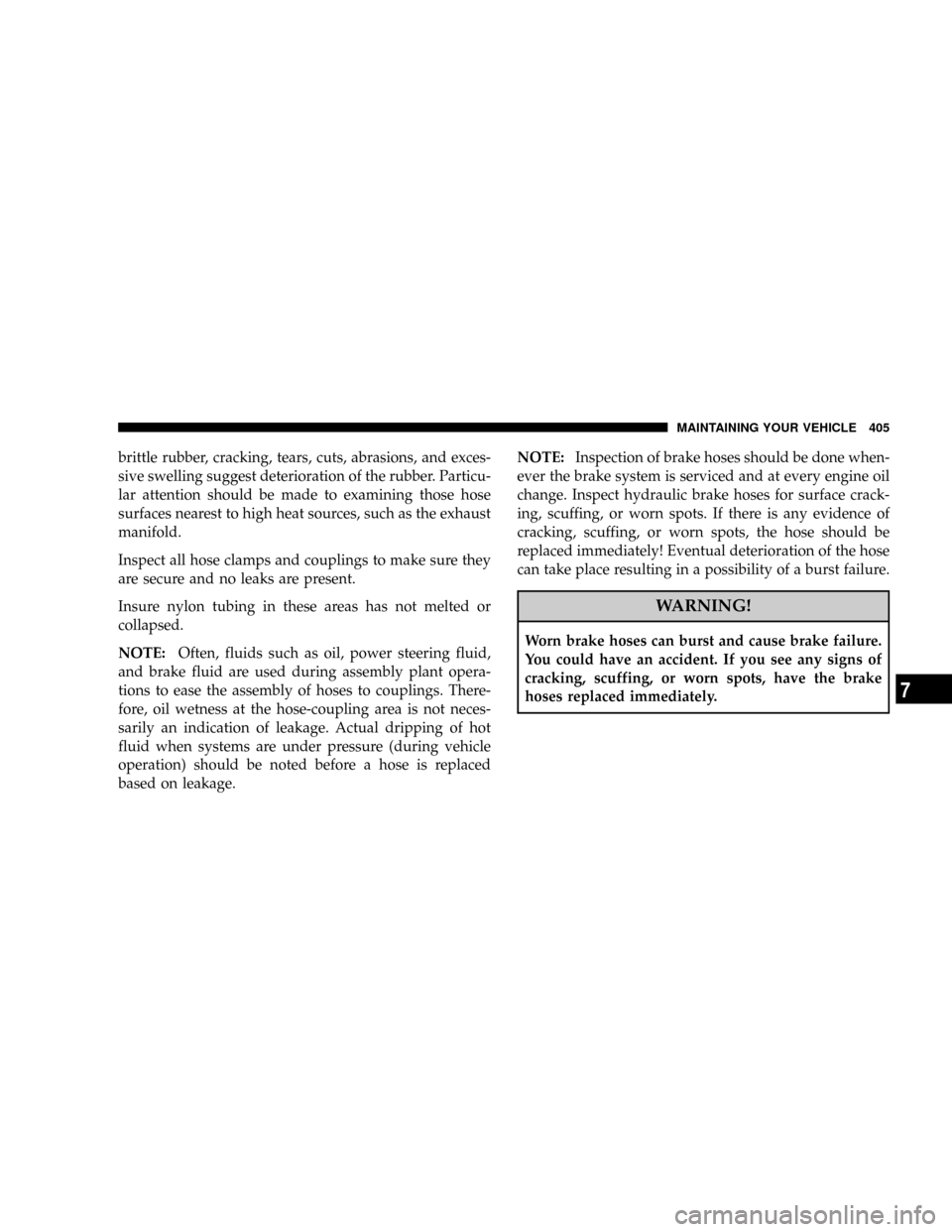
brittle rubber, cracking, tears, cuts, abrasions, and exces-
sive swelling suggest deterioration of the rubber. Particu-
lar attention should be made to examining those hose
surfaces nearest to high heat sources, such as the exhaust
manifold.
Inspect all hose clamps and couplings to make sure they
are secure and no leaks are present.
Insure nylon tubing in these areas has not melted or
collapsed.
NOTE:Often, fluids such as oil, power steering fluid,
and brake fluid are used during assembly plant opera-
tions to ease the assembly of hoses to couplings. There-
fore, oil wetness at the hose-coupling area is not neces-
sarily an indication of leakage. Actual dripping of hot
fluid when systems are under pressure (during vehicle
operation) should be noted before a hose is replaced
based on leakage.NOTE:Inspection of brake hoses should be done when-
ever the brake system is serviced and at every engine oil
change. Inspect hydraulic brake hoses for surface crack-
ing, scuffing, or worn spots. If there is any evidence of
cracking, scuffing, or worn spots, the hose should be
replaced immediately! Eventual deterioration of the hose
can take place resulting in a possibility of a burst failure.
WARNING!
Worn brake hoses can burst and cause brake failure.
You could have an accident. If you see any signs of
cracking, scuffing, or worn spots, have the brake
hoses replaced immediately.
MAINTAINING YOUR VEHICLE 405
7
Page 407 of 488
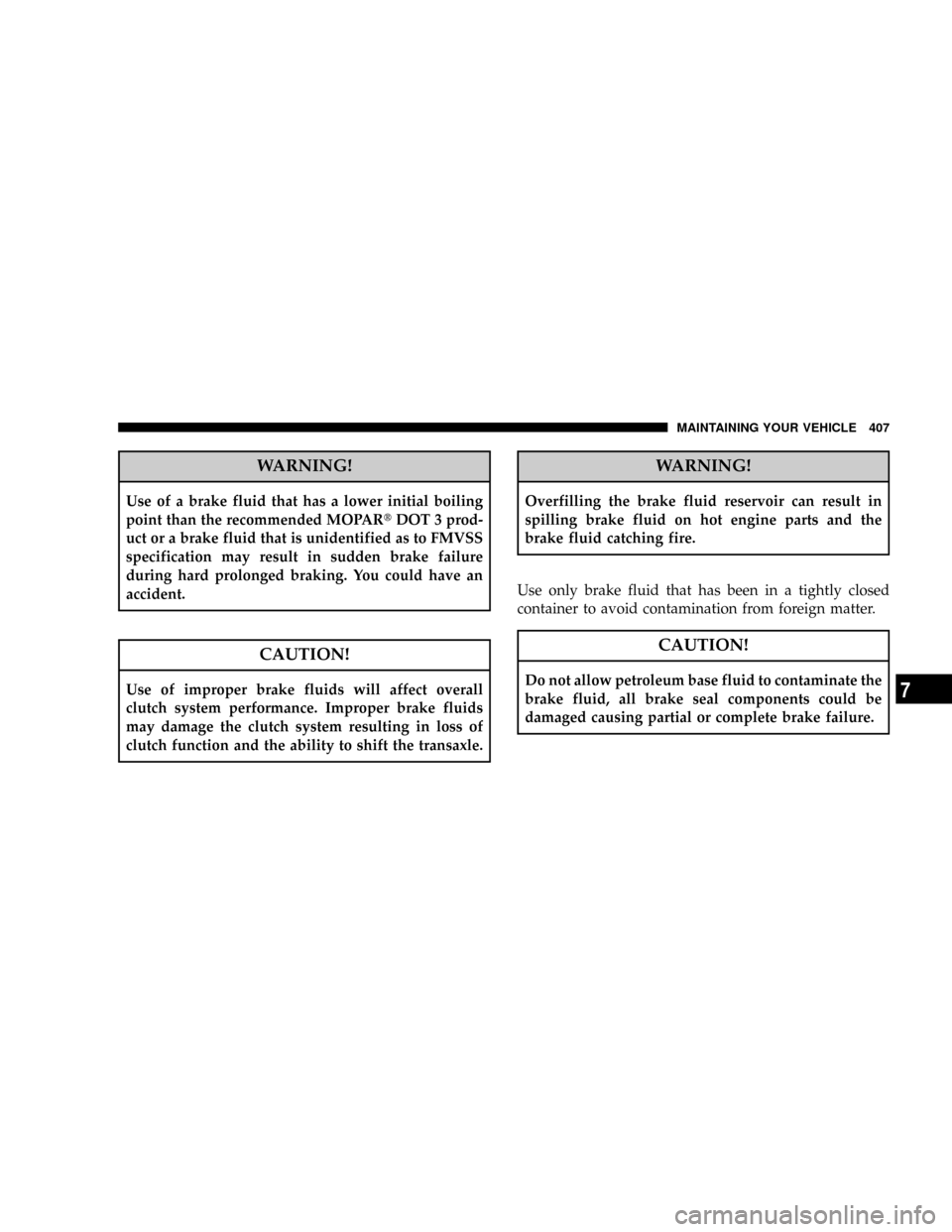
WARNING!
Use of a brake fluid that has a lower initial boiling
point than the recommended MOPARtDOT 3 prod-
uct or a brake fluid that is unidentified as to FMVSS
specification may result in sudden brake failure
during hard prolonged braking. You could have an
accident.
CAUTION!
Use of improper brake fluids will affect overall
clutch system performance. Improper brake fluids
may damage the clutch system resulting in loss of
clutch function and the ability to shift the transaxle.
WARNING!
Overfilling the brake fluid reservoir can result in
spilling brake fluid on hot engine parts and the
brake fluid catching fire.
Use only brake fluid that has been in a tightly closed
container to avoid contamination from foreign matter.
CAUTION!
Do not allow petroleum base fluid to contaminate the
brake fluid, all brake seal components could be
damaged causing partial or complete brake failure.
MAINTAINING YOUR VEHICLE 407
7
Page 408 of 488

AUTOMATIC TRANSAXLE
The automatic transaxle and differential assembly are
contained within a single housing.
The fluid level in the automatic transaxle should be
checked whenever the vehicle is serviced. Operation with
an improper fluid level will greatly reduce the life of the
transaxle and the fluid.
FLUID LEVEL CHECK Ð FOUR-CYLINDER
ENGINES
Use the following procedure to check the automatic
transaxle fluid level properly:
1. Park the vehicle on level ground.
2. Run the engine at curb idle speed for a minimum of 60
seconds.
3. Apply the parking brake fully.4. Place the gear selector momentarily in each gear
position ending with the lever in ªPº (Park).
5. Wipe the area around the dipstick clean to eliminate
the possibility of dirt entering the transaxle.
6. Remove the dipstick and determine if the fluid is hot
or cold. Hot fluid is approximately 180É F (82É C), which
is the normal operating temperature after the vehicle is
driven at least 15 miles (24 km). Hot fluid cannot be held
comfortably between the fingertips. Cold fluid is at a
temperature below 80ÉF (27ÉC).
7. Wipe the dipstick clean and reinsert until seated. Then,
remove dipstick and note the reading.
a. If the fluid is hot, the reading should be in the
crosshatched area marked ªHOTº (between the upper
two holes in the dipstick).
b. If the fluid is cold, the fluid level should be between
the lower two holes in the area marked ªCOLD.º
408 MAINTAINING YOUR VEHICLE
Page 409 of 488
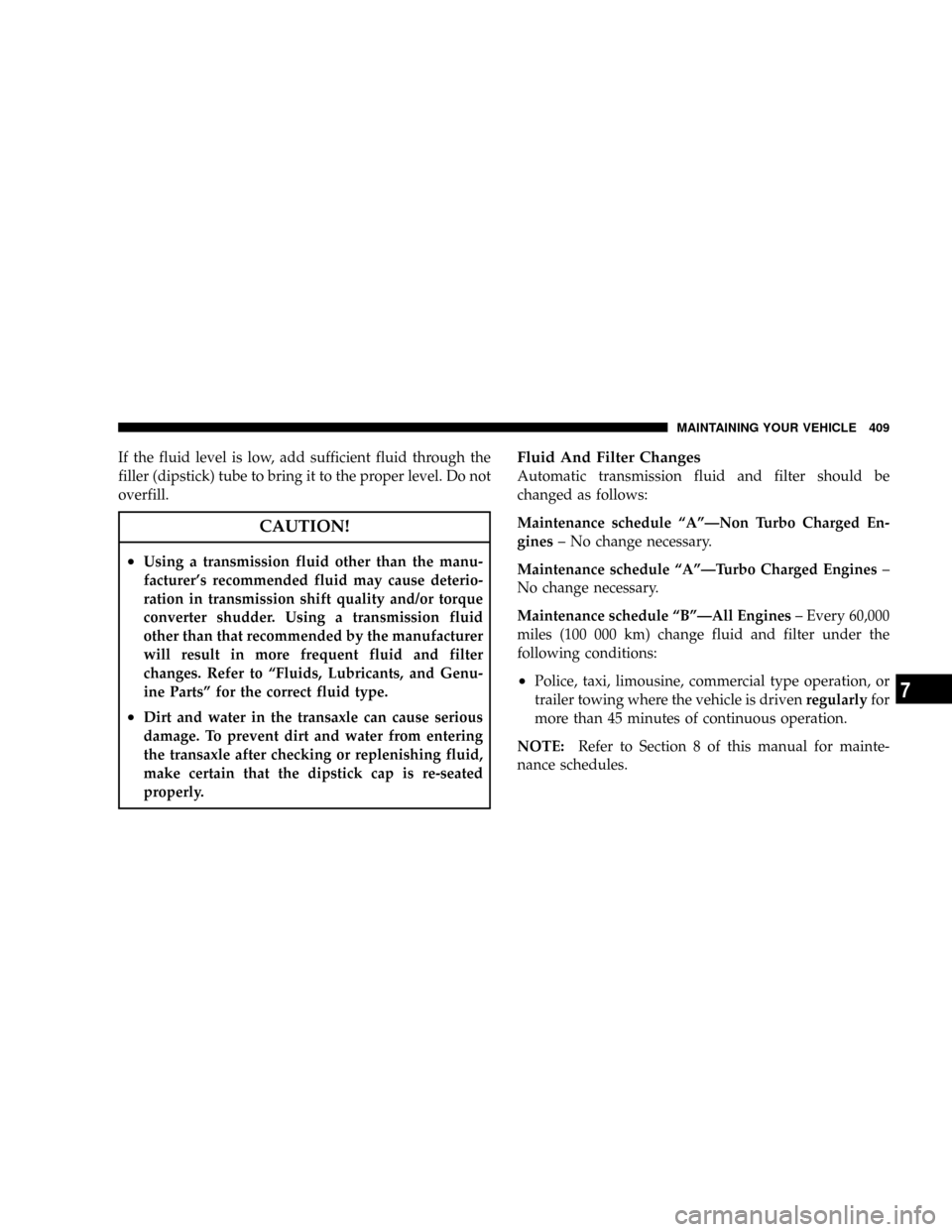
If the fluid level is low, add sufficient fluid through the
filler (dipstick) tube to bring it to the proper level. Do not
overfill.
CAUTION!
²Using a transmission fluid other than the manu-
facturer's recommended fluid may cause deterio-
ration in transmission shift quality and/or torque
converter shudder. Using a transmission fluid
other than that recommended by the manufacturer
will result in more frequent fluid and filter
changes. Refer to ªFluids, Lubricants, and Genu-
ine Partsº for the correct fluid type.
²Dirt and water in the transaxle can cause serious
damage. To prevent dirt and water from entering
the transaxle after checking or replenishing fluid,
make certain that the dipstick cap is re-seated
properly.
Fluid And Filter Changes
Automatic transmission fluid and filter should be
changed as follows:
Maintenance schedule ªAºÐNon Turbo Charged En-
gines± No change necessary.
Maintenance schedule ªAºÐTurbo Charged Engines±
No change necessary.
Maintenance schedule ªBºÐAll Engines± Every 60,000
miles (100 000 km) change fluid and filter under the
following conditions:
²Police, taxi, limousine, commercial type operation, or
trailer towing where the vehicle is drivenregularlyfor
more than 45 minutes of continuous operation.
NOTE:Refer to Section 8 of this manual for mainte-
nance schedules.
MAINTAINING YOUR VEHICLE 409
7
Page 410 of 488

If the transaxle is disassembled for any reason, the fluid
and filter should be changed.
Special Additives
Automatic Transmission Fluid (ATF) is an engineered
product and its performance may be impaired by supple-
mental additives. Therefore, do not add any fluid addi-
tives to the transaxle. The only exception to this policy is
the use of special dyes to aid in detecting fluid leaks. In
addition, avoid using transmission sealers as they may
adversely affect seals.
MANUAL TRANSAXLE
Lubricant Selection
Use only manufacturers recommended transmission
fluid.Refer to Fluids, Lubricants and Genuine Parts for
the correct fluid type.
Fluid Level Check
Check the fluid level by removing the fill plug. The fluid
level should be between the bottom of the fill hole and a
point not more that 3/16º (4.7 mm) below the bottom of
the hole.
Add fluid, if necessary, to maintain the proper level.
Frequency Of Fluid Change
Under normal operating conditions, the fluid installed at
the factory will give satisfactory lubrication for the life of
the vehicle. Fluid changes are not necessary unless the
following conditions exist:
²The lubricant has become contaminated with water. If
contaminated with water, the fluid should be changed
immediately.
²If severe usage has occurred, refer to Maintenance
Schedule ªBº in Section 8 of this manual.
410 MAINTAINING YOUR VEHICLE
Page 419 of 488
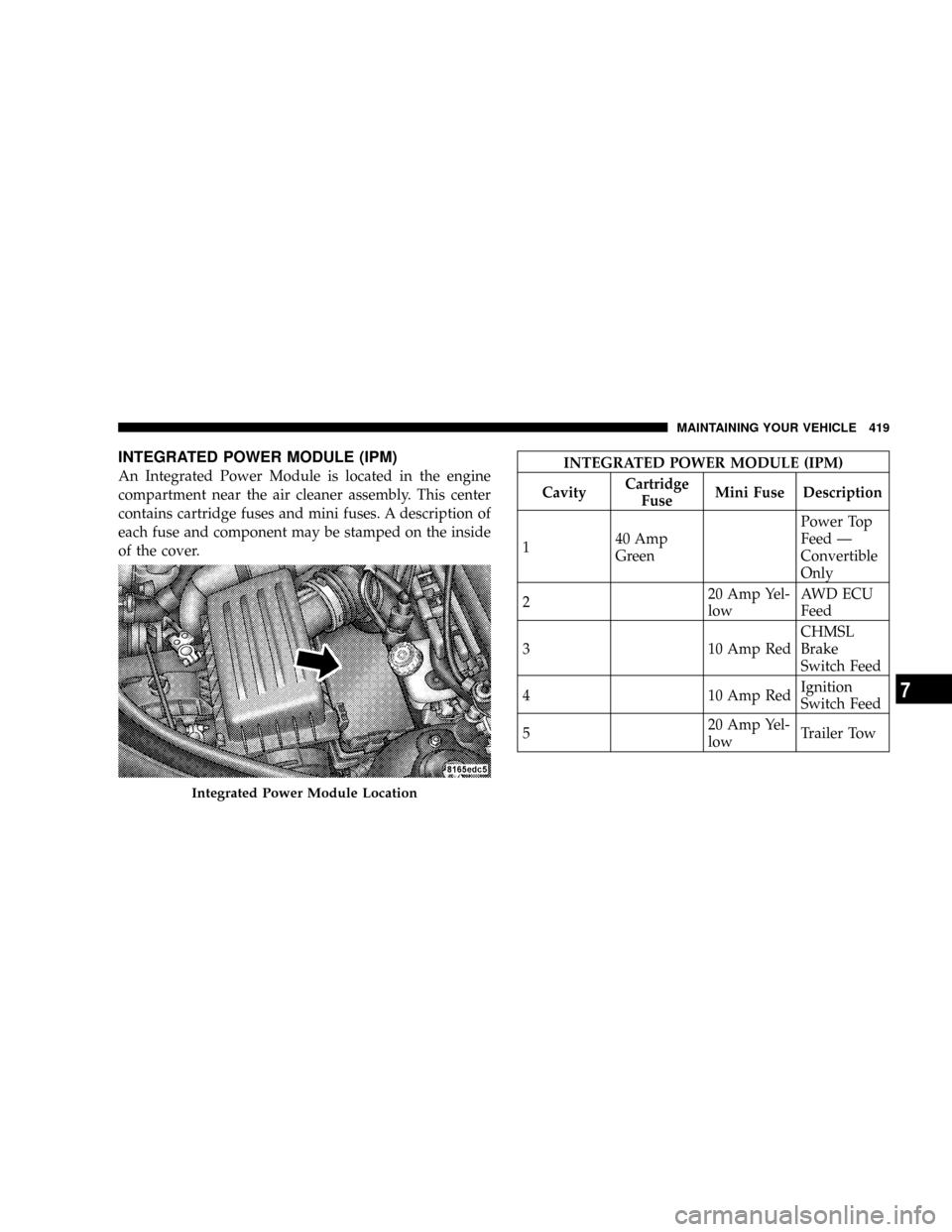
INTEGRATED POWER MODULE (IPM)
An Integrated Power Module is located in the engine
compartment near the air cleaner assembly. This center
contains cartridge fuses and mini fuses. A description of
each fuse and component may be stamped on the inside
of the cover.INTEGRATED POWER MODULE (IPM)
CavityCartridge
FuseMini Fuse Description
140 Amp
GreenPower Top
Feed Ð
Convertible
Only
220 Amp Yel-
lowAWD ECU
Feed
3 10 Amp RedCHMSL
Brake
Switch Feed
4 10 Amp RedIgnition
Switch Feed
520 Amp Yel-
lowTrailer Tow
Integrated Power Module Location
MAINTAINING YOUR VEHICLE 419
7
Page 429 of 488

FLUIDS AND CAPACITIES
FLUIDS AND CAPACITIES
U.S. Metric
Fuel (Approximate)15 Gallons 56.7 Liters
Engine Oil-With Filter
2.4 Liter Engines (Use API Certified
SAE 5W-30 Engine Oil.)5.0 qts 4.7 Liters
Cooling System *
2.4 Liter Engines (Mopart
Antifreeze/Coolant 5 Year/100,000
Miles Formula), or equivalent.6.5 qts 6.2 Liters
* Includes heater and coolant recovery bottle filled to MAX level.
MAINTAINING YOUR VEHICLE 429
7
Page 430 of 488
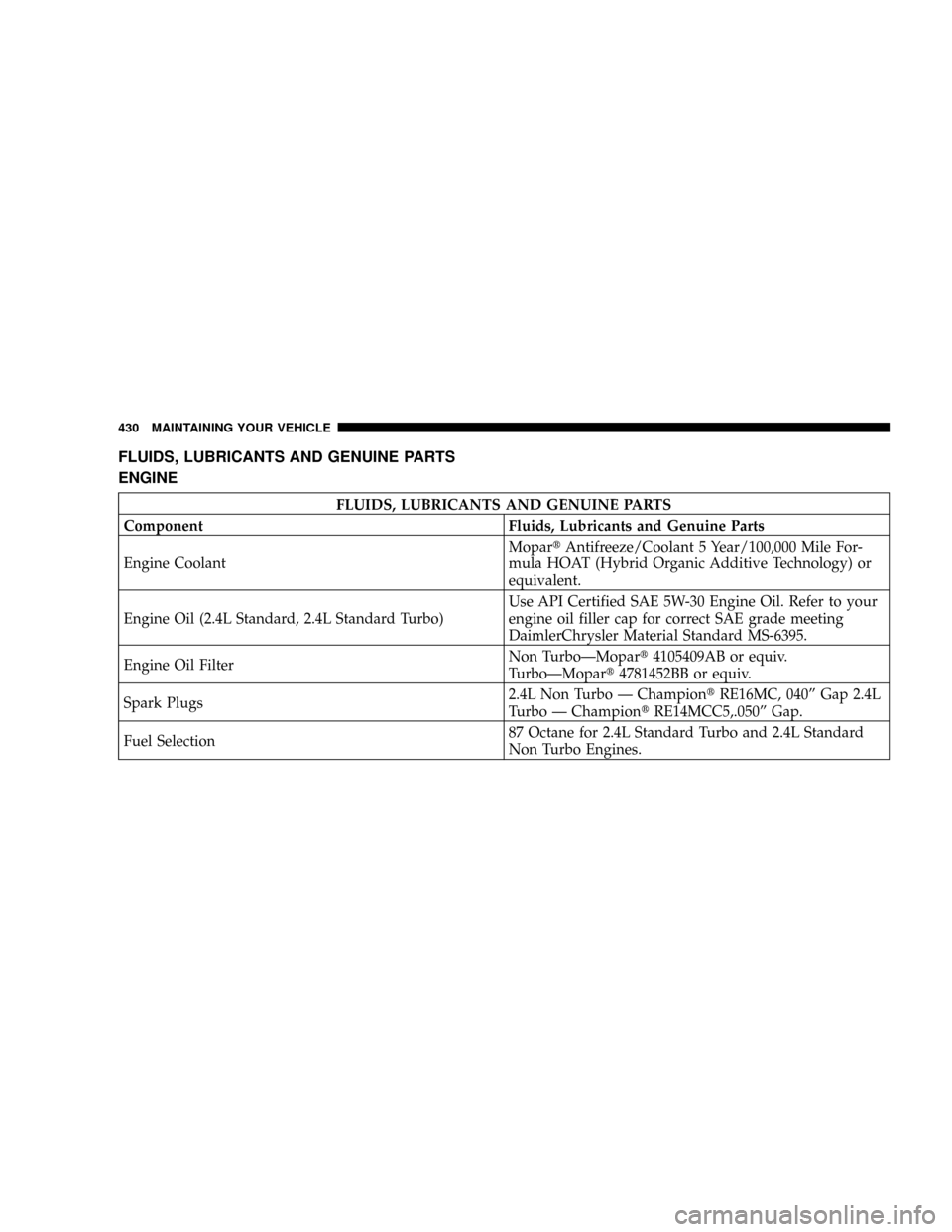
FLUIDS, LUBRICANTS AND GENUINE PARTS
ENGINE
FLUIDS, LUBRICANTS AND GENUINE PARTS
Component Fluids, Lubricants and Genuine Parts
Engine CoolantMopartAntifreeze/Coolant 5 Year/100,000 Mile For-
mula HOAT (Hybrid Organic Additive Technology) or
equivalent.
Engine Oil (2.4L Standard, 2.4L Standard Turbo)Use API Certified SAE 5W-30 Engine Oil. Refer to your
engine oil filler cap for correct SAE grade meeting
DaimlerChrysler Material Standard MS-6395.
Engine Oil FilterNon TurboÐMopart4105409AB or equiv.
TurboÐMopart4781452BB or equiv.
Spark Plugs2.4L Non Turbo Ð ChampiontRE16MC, 040º Gap 2.4L
Turbo Ð ChampiontRE14MCC5,.050º Gap.
Fuel Selection87 Octane for 2.4L Standard Turbo and 2.4L Standard
Non Turbo Engines.
430 MAINTAINING YOUR VEHICLE
Page 433 of 488
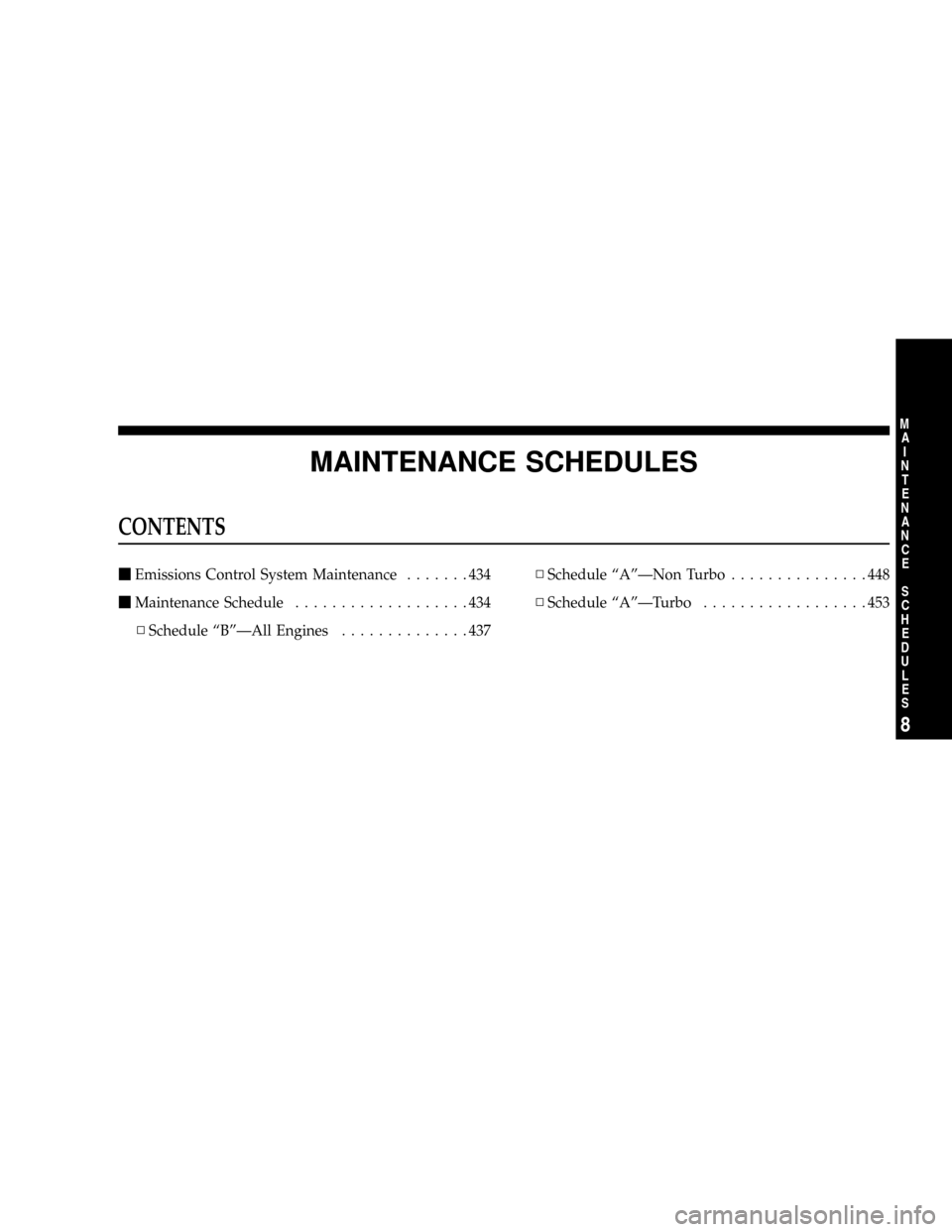
MAINTENANCE SCHEDULES
CONTENTS
mEmissions Control System Maintenance.......434
mMaintenance Schedule...................434
NSchedule ªBºÐAll Engines..............437NSchedule ªAºÐNon Turbo...............448
NSchedule ªAºÐTurbo..................453
8
M
A
I
N
T
E
N
A
N
C
E
S
C
H
E
D
U
L
E
S
Page 434 of 488
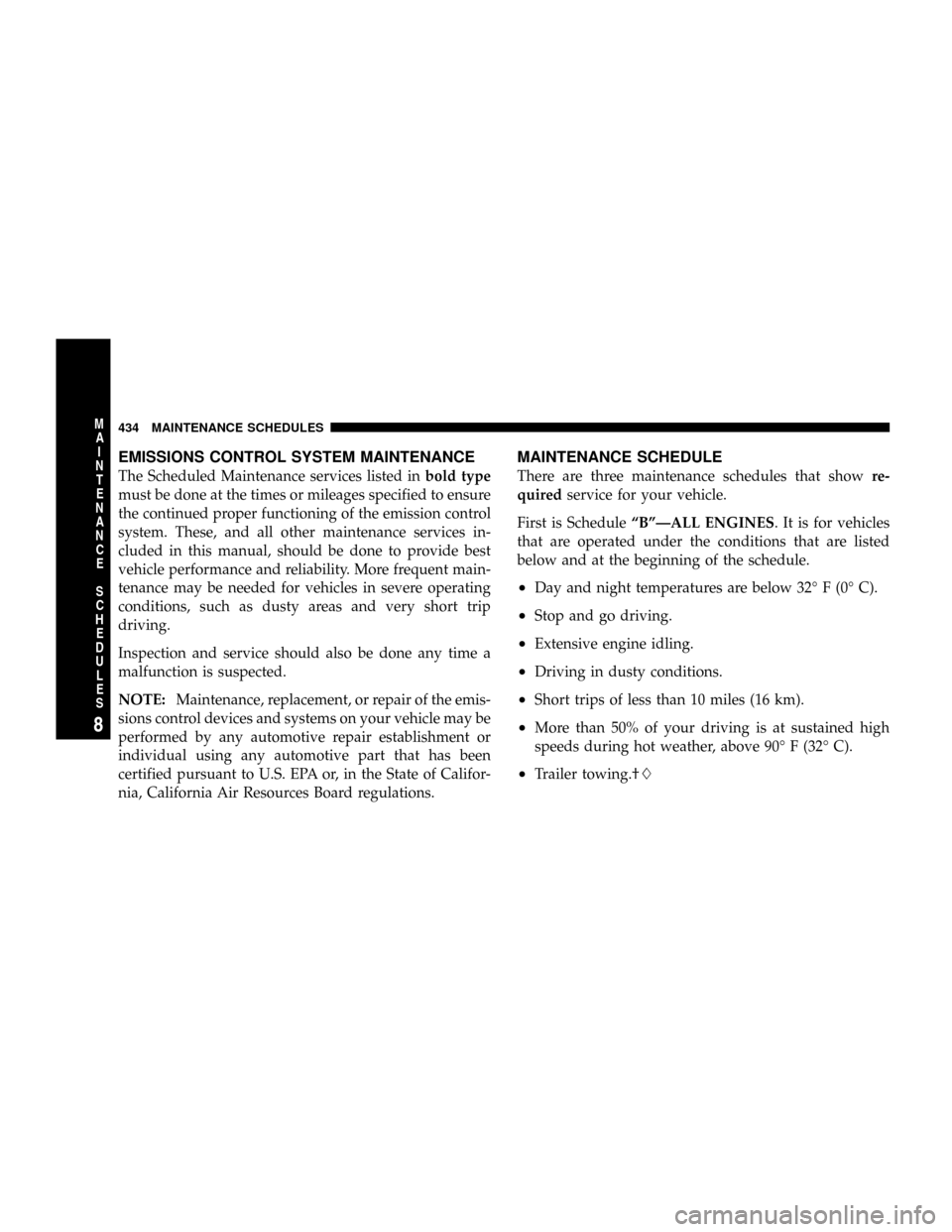
EMISSIONS CONTROL SYSTEM MAINTENANCE
The Scheduled Maintenance services listed inbold type
must be done at the times or mileages specified to ensure
the continued proper functioning of the emission control
system. These, and all other maintenance services in-
cluded in this manual, should be done to provide best
vehicle performance and reliability. More frequent main-
tenance may be needed for vehicles in severe operating
conditions, such as dusty areas and very short trip
driving.
Inspection and service should also be done any time a
malfunction is suspected.
NOTE:Maintenance, replacement, or repair of the emis-
sions control devices and systems on your vehicle may be
performed by any automotive repair establishment or
individual using any automotive part that has been
certified pursuant to U.S. EPA or, in the State of Califor-
nia, California Air Resources Board regulations.
MAINTENANCE SCHEDULE
There are three maintenance schedules that showre-
quiredservice for your vehicle.
First is ScheduleªBºÐALL ENGINES. It is for vehicles
that are operated under the conditions that are listed
below and at the beginning of the schedule.
²Day and night temperatures are below 32É F (0É C).
²Stop and go driving.
²Extensive engine idling.
²Driving in dusty conditions.
²Short trips of less than 10 miles (16 km).
²More than 50% of your driving is at sustained high
speeds during hot weather, above 90É F (32É C).
²Trailer towing.²L
434 MAINTENANCE SCHEDULES
8
M
A
I
N
T
E
N
A
N
C
E
S
C
H
E
D
U
L
E
S